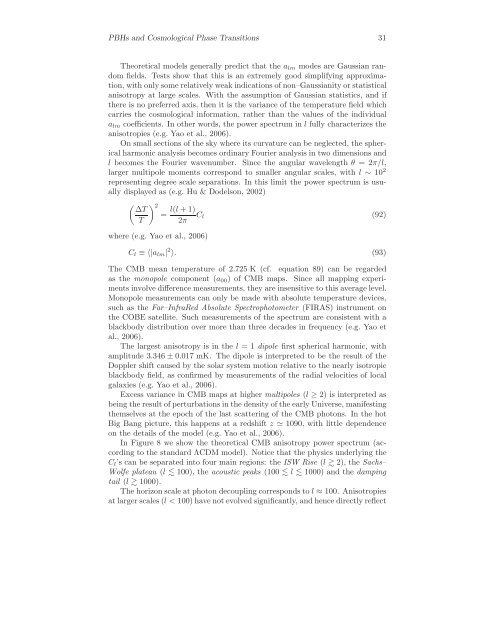Primordial Black Holes and Cosmological Phase Transitions Report ...
Primordial Black Holes and Cosmological Phase Transitions Report ...
Primordial Black Holes and Cosmological Phase Transitions Report ...
Create successful ePaper yourself
Turn your PDF publications into a flip-book with our unique Google optimized e-Paper software.
PBHs <strong>and</strong> <strong>Cosmological</strong> <strong>Phase</strong> <strong>Transitions</strong> 31<br />
Theoretical models generally predict that the alm modes are Gaussian r<strong>and</strong>om<br />
fields. Tests show that this is an extremely good simplifying approximation,<br />
with only some relatively weak indications of non–Gaussianity or statistical<br />
anisotropy at large scales. With the assumption of Gaussian statistics, <strong>and</strong> if<br />
there is no preferred axis, then it is the variance of the temperature field which<br />
carries the cosmological information, rather than the values of the individual<br />
alm coefficients. In other words, the power spectrum in l fully characterizes the<br />
anisotropies (e.g. Yao et al., 2006).<br />
On small sections of the sky where its curvature can be neglected, the spherical<br />
harmonic analysis becomes ordinary Fourier analysis in two dimensions <strong>and</strong><br />
l becomes the Fourier wavenumber. Since the angular wavelength θ =2π/l,<br />
larger multipole moments correspond to smaller angular scales, with l ∼ 10 2<br />
representing degree scale separations. In this limit the power spectrum is usually<br />
displayed as (e.g. Hu & Dodelson, 2002)<br />
∆T<br />
T<br />
2<br />
= l(l + 1)<br />
where (e.g. Yao et al., 2006)<br />
2π Cl (92)<br />
Cl ≡ 〈|alm| 2 〉. (93)<br />
The CMB mean temperature of 2.725 K (cf. equation 89) can be regarded<br />
as the monopole component (a00) of CMB maps. Since all mapping experiments<br />
involve difference measurements, they are insensitive to this average level.<br />
Monopole measurements can only be made with absolute temperature devices,<br />
such as the Far–InfraRed Absolute Spectrophotometer (FIRAS) instrument on<br />
the COBE satellite. Such measurements of the spectrum are consistent with a<br />
blackbody distribution over more than three decades in frequency (e.g. Yao et<br />
al., 2006).<br />
The largest anisotropy is in the l =1dipole first spherical harmonic, with<br />
amplitude 3.346 ± 0.017 mK. The dipole is interpreted to be the result of the<br />
Doppler shift caused by the solar system motion relative to the nearly isotropic<br />
blackbody field, as confirmed by measurements of the radial velocities of local<br />
galaxies (e.g. Yao et al., 2006).<br />
Excess variance in CMB maps at higher multipoles (l ≥ 2) is interpreted as<br />
being the result of perturbations in the density of the early Universe, manifesting<br />
themselves at the epoch of the last scattering of the CMB photons. In the hot<br />
Big Bang picture, this happens at a redshift z 1090, with little dependence<br />
on the details of the model (e.g. Yao et al., 2006).<br />
In Figure 8 we show the theoretical CMB anisotropy power spectrum (according<br />
to the st<strong>and</strong>ard ΛCDM model). Notice that the physics underlying the<br />
Cl’s can be separated into four main regions: the ISW Rise (l 2), the Sachs–<br />
Wolfe plateau (l 100), the acoustic peaks (100 l 1000) <strong>and</strong> the damping<br />
tail (l 1000).<br />
The horizon scale at photon decoupling corresponds to l ≈ 100. Anisotropies<br />
at larger scales (l
















